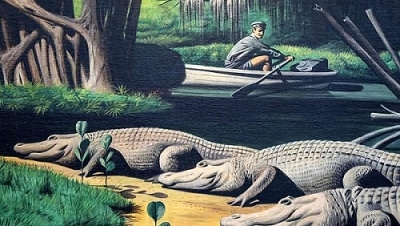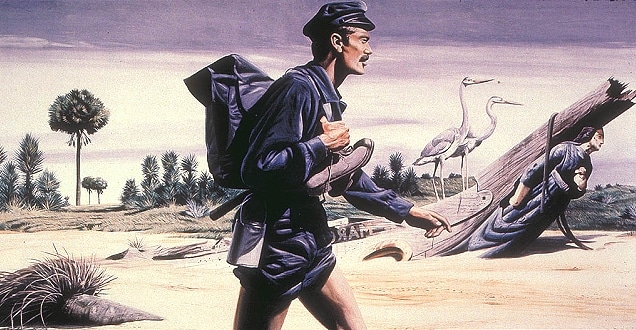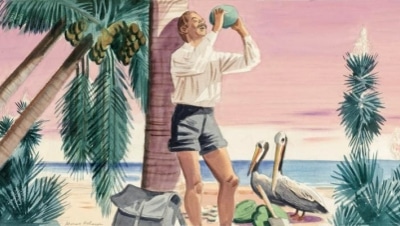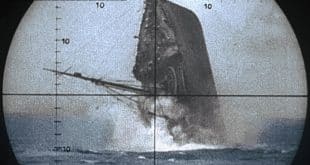In the mid-19th century, the sixty-eight mile stretch of coastline between present-day Palm Beach and Miami had remained largely untouched since Ponce de Leon sailed past in 1513. Local Native American tribes such as the Jeaga and Tekesta had disappeared in the early 1700s, but it was still wild country with Florida cougars and black bears roaming freely along beaches and inlets infested with alligators.
Starting in 1867, mail was delivered as far south as Jupiter on the northern boundary of present-day Palm Beach County via steamer from Titusville, 150 miles away. Jupiter was the southern terminus of the United States Postal Service’s Star Route 6451. A beach walker was added to continue carrying the mail from Jupiter to Miami, but for reasons unknown this was suspended after only two years.
By the early 1880s, South Florida was attracting a steady stream of pioneers and settlers, but there was still no direct mail service between Palm Beach and Miami. In fact, there was no Palm Beach. Back then it was a nameless barrier island that was part of the region known as Lake Worth Country, but the thousands of coconuts that had been planted following the wreck of the Providencia in 1878 were sprouting everywhere and the island would soon have its world-famous name.
In December 1884, the United States Postal Service reactivated the Lake Worth Country to Miami portion of Star Route 6451 using contracted mail carriers who mostly walked along the beach.

These hardy souls were the legendary Barefoot Mailmen. And legendary they were. Have you ever trudged through a mile of beach sand? How about eighty miles under a blazing Florida sun? While carrying a large haversack stuffed to the hilt with mail slung over your shoulder?
And all for $600 a year.
The first contract was awarded in January 1885 to retired Chicago newsman, Lantana settler, and future Dade County school superintendent Edward Ruthven Bradley. He alternated weekly duties with his son Louie for almost two years.
The third, most famous and ill-fated was James “Ed” Hamilton. A native of Cadiz, Kentucky, Hamilton disappeared while trying to cross the Hillsboro Inlet on his way south to Miami on October 11, 1887. Usually a small boat would be hidden in the bushes on the northern side of the inlet, but someone had already taken it across. Hamilton hung his mail sack and clothes in a tree, jumped in the water and was never heard from again. It is theorized that he drowned, but it’s more likely he met a grisly fate. The Hillsboro Inlet was inhabited by hundreds of alligators.
The mail carrier’s route began on Monday morning in Hypoluxo where he picked up the mail (during the first two years, from 1885-1887, the route began ten miles further north in Palm Beach). He sailed to the southern tip of the Lake Worth Lagoon to be deposited on a sandy ridge near the present-day Boynton Beach Inlet. He walked a short distance over the ridge to the beach and it was here that the carrier transformed into the Barefoot Mailman. Shirt off, shoes off, sometimes trousers off (who would know?) and all stuffed into his haversack along with a canvas mail sack. The lightweight canvas mail sack was a major concession by the United States Postal Service. All other mail carriers in America were required to use the standard, heavier mail sack made of cowhide.
The Barefoot Mailman walked south along Boynton Beach and rested his first night at the Orange Grove House of Refuge (for shipwrecked sailors) just north of present-day Atlantic Avenue in Delray Beach. On Tuesday he hiked more than twenty miles of beach until he reached the Hillsborough Inlet near Pompano Beach and crossed in a small boat kept hidden in the bushes (this is where James “Ed” Hamilton disappeared). He would continue along the beach to the Fort Lauderdale House of Refuge and spend the night.
On Wednesday, the Barefoot Mailman was transported by boat down the New River to its inlet and then walked down the beach until he reached Baker’s Haulover at the north end of Biscayne Bay. Finally, he sailed across Biscayne Bay to deliver the mail in Miami and get as much sleep as possible before he began his return trip early Thursday.
The round trip totaled 136 miles. Eighty by foot and fifty-six by boat. The Barefoot Mailman reached the end of his return trip to Palm Beach by late Saturday, rested Sunday and started all over again early Monday.
To supplement their salary, some of the Barefoot Mailmen allowed a traveler to accompany them for five dollars (equivalent to three days’ wages). They believed their fee was justified because the mail carrier was forced to walk slower with the inexperienced walkers and ferry them across the various inlets.
The need for the Barefoot Mailman ended in January 1893 with the building of a road from Lantana (eight miles south of Palm Beach) to Lemon City (six miles north of Miami). This signaled the official end of the Pioneer Era in South Florida and the beginning of the Henry Flagler Era.
There were at least fifteen Barefoot Mailmen. Besides Edward Ruthven Bradley, his son Louie, and James “Ed” Hamilton, they included Andrew Garnett, Charles W. Pierce, George Charter, Bob Douthit, Dan McCarley, Frederick Matthaus, Otto Matthaus, George Sears and a man known only as Stafford. The last carrier under contract, and probably the fastest, was Henry John Burkhardt. The last to walk the route were Edward “Ned” Peat and Dan Kelley from 1891-1893, but neither was under contract with the U.S. Postal Service.
During the Barefoot Mailmen era (1885-1893), the carriers were referred to as beach walkists or beach walkers. Charles W. Pierce was the first to use the term Barefoot Mailman in 1939 in conversations with artist Stevan Dohanos who was painting murals of James “Ed” Hamilton for the West Palm Beach post office. The images in this article represent three of the six murals on display at the post office on Summit Boulevard in West Palm Beach. The Palm Beach Post was the first to publish the term Barefoot Mailman in 1940.
Based on the 1943 novel by Theodore Pratt, the comedy-adventure movie The Barefoot Mailman, starring Bob Cummings and Terry Moore, was released by Columbia Pictures in 1951.
BEST West Palm Beach Concert & Event Tickets!
Want the Best Price for a West Palm Beach Hotel?

WestPalmBeach.com
The Visitor’s Guide to West Palm Beach!








